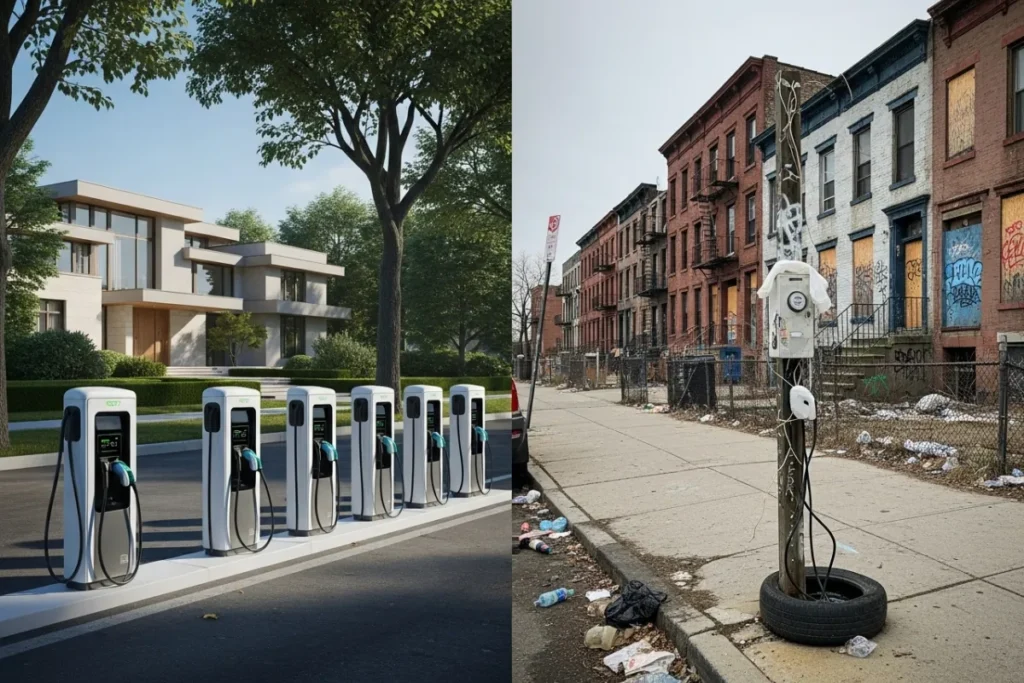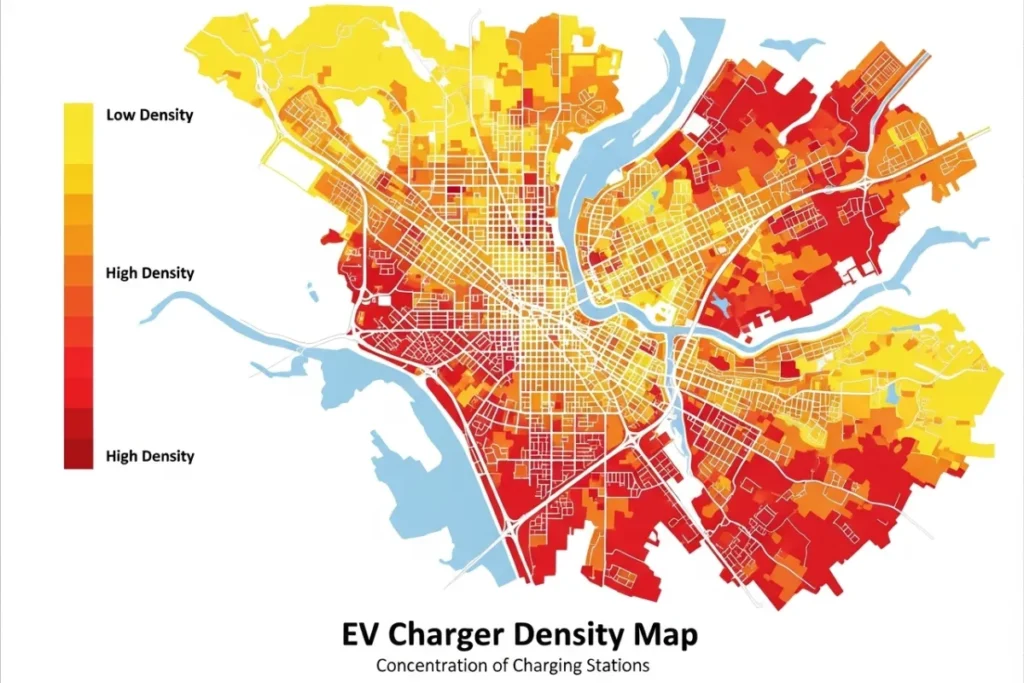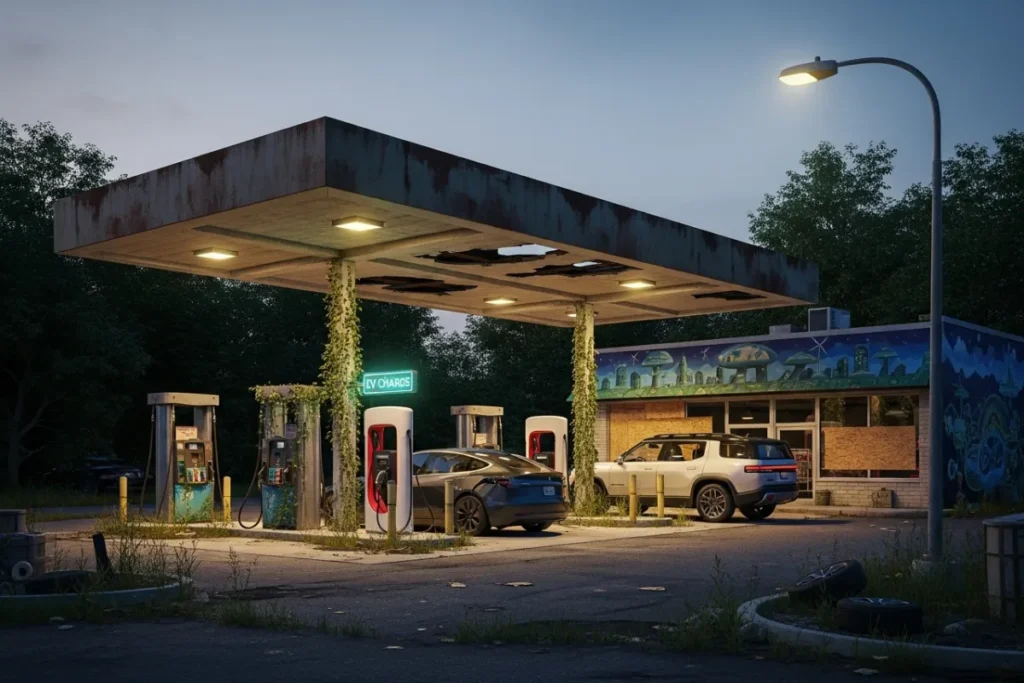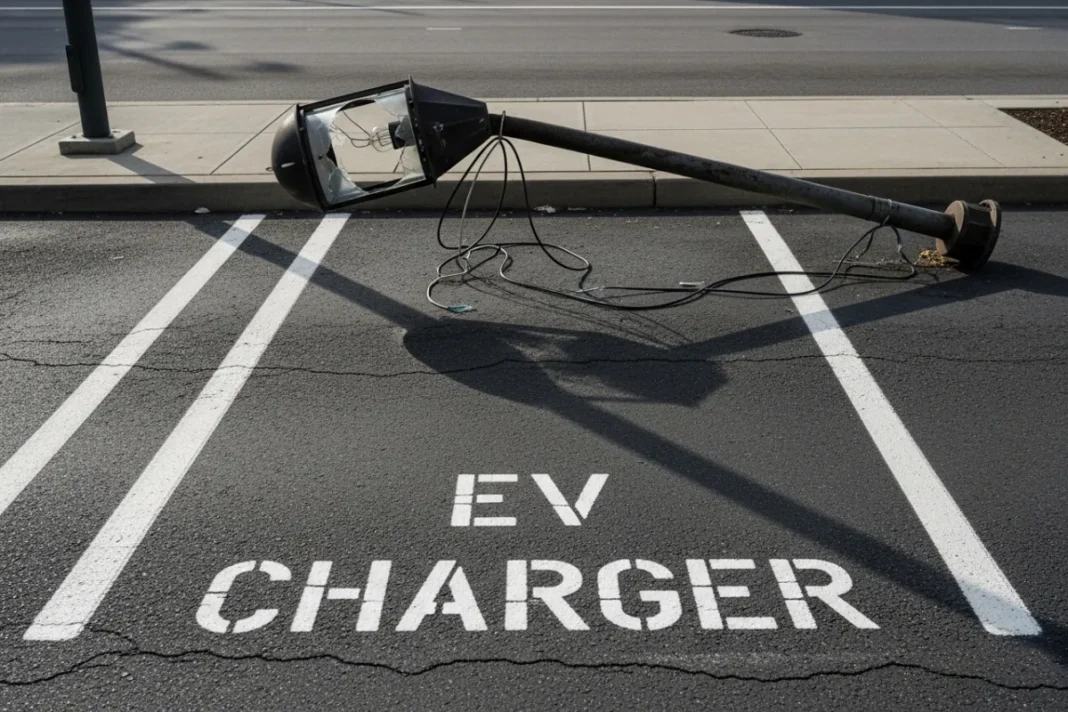Explore the surge in electric vehicle adoption and the critical role of equitable EV charging infrastructure in urban areas. This blog delves into the disparities in access to charging stations among various socioeconomic groups, the impact of public versus private charging solutions, and case studies of cities aiming to bridge the EV infrastructure gap. Learn about potential solutions to ensure all communities benefit from the transition to electric mobility, addressing existing inequalities while promoting environmental justice.
Table of Contents
Introduction to Electric Vehicle Adoption
The adoption of electric vehicles (EVs) has witnessed a significant surge in recent years, particularly in urban areas where environmental concerns and technological advancements converge. As cities strive to meet climate goals, the transition to EVs emerges as a pivotal strategy to mitigate greenhouse gas emissions and combat climate change. The shift towards electric transportation not only reduces reliance on fossil fuels but also attracts a growing number of consumers who recognize the long-term economic and environmental benefits of EV ownership.
Urban populations, in particular, display heightened interest in adopting electric vehicles, driven largely by incentives such as tax breaks, rebates, and a growing awareness of the benefits of sustainable practices. The proliferation of electric vehicles signifies more than just a technological advancement; it underscores the need for comprehensive urban planning that accommodates new infrastructure demands. However, as the demand for EVs rises, so too does the importance of addressing the disparities in urban EV charger access. The concept of a “charging desert” emerges as a critical concern, highlighting areas inadequately equipped with public or private charging stations, thereby affecting potential EV owners.
Moreover, the existing EV infrastructure gap reveals significant inequities in charging availability between affluent neighborhoods and underserved areas. While wealthier demographics may enjoy the convenience of home charging, lower-income communities often face barriers that limit their access to essential charging facilities. This imbalance raises questions around EV equity solutions, urging policymakers and stakeholders to consider the implications of public versus private charging solutions. To maximize the benefits of electric vehicle adoption, it is crucial to develop an inclusive framework that ensures equitable access to charging resources across all urban populations.
Understanding Electric Car Charging Infrastructure
The electric vehicle (EV) charging infrastructure is essential for encouraging widespread adoption of electric cars, particularly in urban areas where disparities in access are most pronounced. Charging infrastructure primarily comprises three types of chargers: Level 1, Level 2, and DC fast chargers. These chargers differ in charging speed, power output, and location, contributing significantly to the overall user experience.
Level 1 chargers, which typically use standard household outlets, deliver a slow charging rate, making them most suitable for home charging scenarios. However, their practicality is limited in public spaces due to the long charging times associated with them. On the other hand, Level 2 chargers, commonly found in commercial locations and public areas, provide a faster alternative, reducing waiting times for users. DC fast chargers are the most powerful and can provide substantial charges in a matter of minutes, making them ideal for intercity travel and urban environments where time is a critical factor.
The location of these chargers is pivotal to their effectiveness. Access to charging infrastructure is often determined by whether they are publicly or privately available, creating a discrepancy known as the “charging desert” in various urban settings. Areas lacking adequate public charging facilities may discourage residents from investing in EVs, thereby perpetuating the EV infrastructure gap. This situation is particularly troubling in low-income neighborhoods, where public charging options may be scarce or absent, exacerbating inequities in accessing sustainable transportation.
Addressing these gaps is not merely a matter of convenience; it directly relates to EV equity solutions. Ensuring that all urban dwellers have equitable access to charging facilities will promote greater adoption of electric vehicles, thereby supporting efforts to reduce emissions and improve air quality. Enhanced collaboration between the public and private sectors is essential to establish robust EV charging networks that meet the needs of diverse communities.

Socioeconomic Disparities in Charger Access
The accessibility of electric vehicle (EV) chargers serves as a vital component in the broader context of urban infrastructure and transportation equity. In many metropolitan areas, a significant disparity emerges when examining the availability of charging stations across different socioeconomic groups. Wealthier neighborhoods tend to enjoy a more robust EV infrastructure, often benefiting from a higher concentration of charging stations. This situation creates a stark contrast with low-income areas, frequently regarded as charging deserts, where residents confront significant barriers in accessing reliable charging solutions.
Access to urban EV charger networks is pivotal, as it directly impacts the adoption rate of electric vehicles. Communities situated in affluent neighborhoods commonly see an increase in residential charging stations and public charging facilities, incentivizing EV ownership. Conversely, low-income communities, lacking substantial public and private charging options, become victims of systemic inequality, further entrenching their socioeconomic struggles. This disparity solidifies the electric vehicle charging inequality narrative and raises questions about the equitable distribution of EV infrastructure.
Public versus private charging solutions also play a crucial role in exacerbating these disparities. While private charging stations offer the convenience of home recharging to wealthier households, the absence of a comprehensive public charging infrastructure leaves low-income residents deprived of essential EV resources. Moreover, municipal policymakers often overlook the specific needs of marginalized communities while planning infrastructure projects. EV equity solutions must prioritize not only the installation of charging stations but also ensure that these resources are evenly distributed to bridge the EV infrastructure gap.
Addressing these socioeconomic disparities is essential for fostering an inclusive transition to electric mobility. Without proactive measures, the inequalities surrounding urban EV charger access will persist, perpetuating a cycle of inequity that disproportionately affects lower-income populations in cities across the globe.
Impact of Charger Placement on Urban Communities
The strategic placement of electric vehicle (EV) chargers plays a critical role in shaping urban communities and their development. As cities increasingly embrace electric vehicles, ensuring equitable access to charging infrastructure becomes imperative. Urban EV charger access does not distribute evenly across different neighborhoods, often leaving certain areas, particularly low-income and underprivileged communities, as “charging deserts.” This phenomenon highlights a significant infrastructure gap that must be addressed to promote widespread adoption of electric vehicles.
Geographic and demographic factors significantly influence where chargers are located. Affluent neighborhoods tend to have a higher concentration of public charging stations, while areas with economically disadvantaged populations often lack even basic charging solutions. This disparity reflects not only the socio-economic divides within urban centers but also affects residents’ ability to transition to electric vehicles. Thus, understanding the implications of charger placement is essential for urban planners seeking to create equitable access to EV equity solutions.
A well-considered distribution of EV chargers can contribute a range of benefits beyond environmental considerations. It supports local economies, encourages the use of public transportation, and fosters a more sustainable urban growth model. The debate between public vs. private charging solutions underscores the need for collaboration between government entities and private companies to fill the gaps in the current EV infrastructure landscape. By ensuring that charging stations are placed strategically in areas with high demand, cities can enhance urban EV charger access while simultaneously promoting inclusivity and reducing the urban divide.
In conclusion, addressing the impact of charger placement on urban communities is essential for creating an equitable environment in which all residents can benefit from the transition to electric vehicles. Urban planners and stakeholders must collaborate to implement effective strategies that close the EV infrastructure gap and ensure comprehensive access to charging solutions for all, especially in underserved areas.

Pricing Policies and Their Role in Charging Inequality
The effectiveness of electric vehicle (EV) adoption is significantly influenced by the pricing policies associated with charging infrastructure. As cities strive to enhance urban EV charger access, disparities arise largely due to the costs associated with public versus private charging stations. For instance, pay-per-use charging stations can act as a barrier for low-income communities, who may struggle to afford even modest fees. In contrast, free charging options, though they have their own set of limitations, can provide essential access to EVs for economically disadvantaged individuals.
The charging desert phenomenon becomes critical in this discussion. Areas with limited or no charging access often coincide with lower-income neighborhoods, creating a significant EV infrastructure gap. This gap perpetuates a cycle where wealthier communities have more resources to invest in electric vehicles, while those in less affluent areas are left with fewer choices. Thus, pricing structures play a pivotal role in either fostering inclusivity or further entrenching inequality within urban environments.
Additionally, the distinction between public and private charging facilities needs examination. Public stations, which are instrumental for urban EV charger access, often implement varying pricing models that can discourage use in lower-income areas. This disparity underlines the need for equitable pricing strategies that prioritize access over profit. Developing comprehensive equity solutions must include re-evaluating pricing policies to better accommodate economically vulnerable populations. If these disparities are not addressed, the broader goal of a sustainable, electric future risks leaving many behind, exacerbating existing inequalities rather than alleviating them.
Case Studies: Cities Addressing Charging Inequality
As the demand for electric vehicles (EVs) continues to rise, cities across the globe are taking meaningful steps to address the urban EV charger access disparities that contribute to a charging desert for many residents. Recognizing the impact of these inequities on underprivileged communities, local governments are implementing innovative policies and initiatives aimed at bridging the infrastructure gap.
For example, Los Angeles has embarked on an aggressive initiative called “Charge Up LA.” This program is designed to install publicly available chargers in low-income neighborhoods while also facilitating partnerships with local businesses to create charging stations. By strategically placing public vs. private charging options, the city plans to create a comprehensive network of chargers that all residents can access regardless of their economic status. This collaborative approach not only expands charging access but also stimulates local economies.
In a similar vein, Denver has launched a pilot program focusing on integrating EV infrastructure into multifamily housing developments. Recognizing that many urban residents live in apartments without dedicated parking, the program provides funding for building owners to install charging stations. This forward-thinking approach tackles both the physical and financial barriers to equity solutions, ensuring that all city dwellers can benefit from the transition to electric mobility.
Moreover, Seattle has been fostering community engagement by involving local stakeholders in the planning process. Through workshops and public forums, residents voice their needs and concerns regarding charging access. By implementing feedback from various community groups, the city ensures that its policies meet the diverse needs of its citizens, thereby enhancing overall accessibility to EV charging.
These case studies illustrate that addressing charging inequality requires a multifaceted approach, combining policy innovation, public engagement, and partnerships across sectors. By learning from these initiatives, other municipalities can develop tailored solutions to combat urban EV charger access disparities and promote equitable access to electric vehicle charging infrastructure.

The Environmental Justice Perspective
Electric vehicles (EVs) are often heralded as a solution to the growing concerns surrounding climate change and urban air pollution. However, the disparity in urban EV charger access reveals a deeper issue linked to social inequalities. Specifically, the lack of charging infrastructure in low-income and marginalized communities perpetuates the so-called “charging desert,” where residents face obstacles in adopting electric vehicles. This urban EV charger access gap not only limits the adoption of EVs in these areas but also diminishes the environmental benefits that are projected to accrue from widespread EV use.
The implications of inadequate access to EV charging stations directly correspond to the larger economic and social inequalities faced by disadvantaged communities. As municipalities and private entities focus on developing EV infrastructure, attention frequently skews toward affluent neighborhoods, inadvertently excluding those who could benefit the most from switching to electric vehicles. This phenomenon raises significant concerns regarding electric vehicle equity solutions. Communities lacking sufficient charging facilities remain at a distinct disadvantage, unable to tap into the environmental advantages that EVs offer, and effectively reinforcing existing inequalities.
Moreover, the public vs. private charging debate adds another layer to the issue. While some urban areas invest heavily in publicly accessible charging points, others witness a rise in private charging infrastructure that does not serve communities in dire need. The resultant disparity can exacerbate the already stark EV infrastructure gap, leading to a cycle where lower-income families cannot afford the transition to electric mobility. Consequently, these socio-economic barriers limit their participation in a more environmentally conscious future, intensifying discussions around environmental justice.
In conclusion, equitable access to EV charging infrastructure is integral to ensuring that the transition to electric vehicles promotes inclusivity rather than deepening existing urban divides. Addressing urban EV charger access must therefore be a priority in the shift towards sustainable transportation solutions.
Potential Solutions to Electric Car Charging Inequality
Addressing electric car charging inequality requires a multi-faceted approach that engages urban planners, policymakers, and community leaders. One viable solution is the enhancement of public investment in EV infrastructure, particularly in underserved areas often referred to as “charging deserts.” By strategically placing urban EV chargers in these locations, communities lacking access to reliable charging infrastructure can benefit significantly. Similarly, deploying funds to develop charging stations in low-income neighborhoods is crucial for bridging the EV infrastructure gap, ultimately promoting greater EV adoption rates among all demographics.
Government incentives for private entities to install charging stations are another effective strategy. Policies that provide tax credits or rebates for public vs. private charging initiatives can encourage businesses and homeowners to participate in expanding charging access. This collaboration can lead to a more equitable distribution of charging points across cities, ensuring that no community is left behind in the transition to electric vehicles.
Moreover, fostering partnerships between local governments and private companies can catalyze innovative solutions tailored to community needs. For instance, community workshops where residents voice their charging concerns can inform custom-designed EV equity solutions. Such collaborative efforts can also create educational campaigns to raise awareness about available charging options and how to access them. Addressing urban EV charger access is not just about infrastructure; it is also about shifting the mindset of car ownership and charging capabilities in the urban landscape.
In conclusion, addressing the issue of electric car charging inequality will require a concerted effort from all stakeholders involved, emphasizing public funding, private incentives, and community engagement to create a more equitable EV future.
| Approach | Description | Key Stakeholders | Expected Outcome |
|---|---|---|---|
| Public Investment in “Charging Deserts” | Increase funding to install and maintain urban EV chargers in underserved areas (so‑called “charging deserts”), especially low‑income neighborhoods, to bridge infrastructure gaps. | Local/national governments, businesses, and homeowners | Urban planners, municipalities, and funders |
| Government Incentives for Private Installers | Offer tax credits, rebates or grants to businesses and homeowners who install public or private EV charging points, encouraging wider participation in network expansion. | Local authorities, private companies, and community groups | More evenly distributed chargers; accelerated network growth |
| Public–Private & Community Partnerships | Collaborate on community workshops to gather resident input, co‑design equity solutions, and run educational campaigns about charging options and usage. | Offer tax credits, rebates, or grants to businesses and homeowners who install public or private EV charging points, encouraging wider participation in network expansion. | Improved access to reliable charging, higher EV adoption across income levels |
Conclusion: A Call for Equitable Charging Solutions
The advent of electric vehicles (EVs) has the potential to revolutionize urban transportation, but the existing disparities in urban EV charger access highlight significant socioeconomic divides. As discussed, the notion of a charging desert—areas with inadequate charging infrastructure—poses challenges primarily for low-income communities that already struggle to access essential services. This infrastructure gap not only limits the adoption of EVs but also reinforces existing inequalities.
Moreover, the dichotomy between public and private charging stations exacerbates the urban divide. While affluent neighborhoods may thrive with ample private charging options, low-income areas often face a lack of sufficient public EV infrastructure. This inequity can lead to a scenario where only certain demographics can fully benefit from the advantages of electric mobility, thereby perpetuating environmental and social injustices. As the electric vehicle market continues to expand, addressing these disparities must become a priority for city planners, policymakers, and stakeholders in the EV sector.
To bridge the gap in EV infrastructure, urgent action is required, focusing on equitable charging solutions that cater to the needs of all communities. This may involve incentivizing the installation of charging stations in underserved areas, implementing policies that encourage collaborations between public and private sectors, and promoting initiatives that foster EV equity solutions. In advocating for these policy changes, we can ensure that the transition to electric mobility stands as a pillar of sustainability that benefits everyone, effectively diminishing the urban divide. The road ahead remains challenging, but by prioritizing equitable access to EV charging networks, we can pave the way for a more inclusive future in urban environments.





